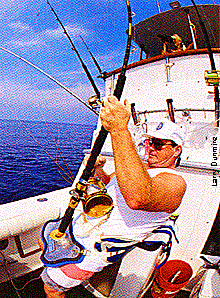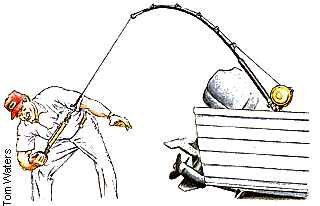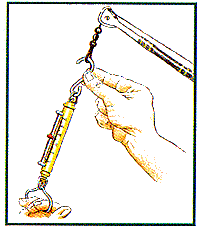

Since the first books and magazine articles appeared years ago on the subject of offshore sport fishing, whole forests' worth of paper have no doubt been sacrificed to the debate over drag settings, especially strike-drag settings. During the last couple of decades, several theories on this subject have been expounded, and many arguments have taken place over which setting is best. Some feel that only enough strike drag should be applied to prevent a backlash, while others subscribe to the hit-'em-straight-off-with-45-percent-drag school of thought. However, this is not a debate I'm going to address here. Today's subject is how to set a strike drag properly.
Recent technological advances have resulted in big improvements in today's drag systems. The ability to protect drags from water and oil intrusion is one. Drag materials like Delrin and HT100 carbon are now being used, and "super lubricants" like 0025 and Jack Erskine's P1-10 Lube have been developed. Superior metal components are also being incorporated, including alloys that don't expand as much when they get hot. Manufacturing techniques and standards have improved, too.
At one time, the heat generated during a fight often produced an unwanted increase in drag. Today, some carbon drag discs actually lose some of their friction coefficient, or "grip", as they heat up, resulting in slight decreases in drag pressure. This is the reason Shimano's Tiagra offshore reels feature a compensating hydraulic piston arrangement, which counters this effect. German engineers are even building magnetic drags in spinning reels (not magnetic cast-controls -- magnetic drags).
All this means that much of the old wives stuff we have heard about reel drags over the decades can be safely discarded. I am still mildly amused, for example, when I see deckhands in southern Australia go around to each reel, clamp down on the spool and crank the handle hard against the strike setting to "warm up the drag." That's something their grandfathers probably saw Zane Grey do in 1936! It is not something a fish will do for you before it takes off in earnest.
I mention this small prejudice of mine only to make the point that in setting a drag it makes the most sense to prepare for what happens in reality. In other words, when setting a drag you should try to duplicate what actually occurs when a big, fast fish slams your lure and hits the afterburners.
Get Real!
The first thing we have to consider in the
drag equation is inertia, or the tendency of an object to resist acceleration. A reel
spool at rest is going to take more force to start spinning than it will to keep spinning
once it gets up to speed. When the spool goes from a standing start to several hundred rpm
in the space of two seconds or less, that initial force is markedly increased. Therefore,
if a drag is set without taking into account the peak inertia, it is likely to be too
heavy when a fish hits.
If you want to set the drag properly, you've got to simulate a real-life fish strike. For the following exercise I am assuming that we have fresh line of known breaking strength on the spool and that the spool is full of line, not half an inch down.
My personal rule of thumb about the strike drag is that it should be set at about 35 percent of the known breaking strength of the line, even though many people recommend 25 to 30 percent. Whatever your reference point, just be sure you set the drag by duplicating what happens when a fish strikes hard.
Setting a drag can be done with a scale that records the high point of resistance. Chatillon and Manley make a series of scales featuring an indicator that remains at the highest reading. This means you don't have to watch the needle like a hawk during the test. More importantly, it means you can carry out the test at true speed.

Setting It Right
To duplicate an actual strike, you must first
attach the reel to a rod and run the line through the guides (never test the drag by
simply pulling line straight off the reel). Then you must either hold the rod at roughly
45 degrees or place it in a gunwale holder. Wind the swivel to the rod tip, hook the scale
to the swivel and yank the scale down and away from the rod as fast as you can. Now check
the indicator on the scale. It's as simple as that. If you set the strike drag at 35
percent under those conditions, then nothing is ever going to break you off on the strike.
After setting the strike drag you can set a second preset "fighting drag" in
the same way, so you'll know precisely what drag, under speed, you have at that point. I
set my fighting drag at around 45 percent of the line's known breaking strength. That way
when things settle down to the tug-of-war stage with a big fish, I can push the lever just
beyond that point to gain about 50 percent more pressure on the fish.  This
is safe to do, provided you don't do it too suddenly. If the fish should make a sudden run
or surge you can instantly pull back to the 35-percent strike setting.
This
is safe to do, provided you don't do it too suddenly. If the fish should make a sudden run
or surge you can instantly pull back to the 35-percent strike setting.
If you would like to test the inertia factor for yourself, try the following: Set a 35-percent drag setting on your favorite reel by simply pulling line straight off the reel at a slow speed. Then take the reel and attach it to a rod set at 45 degrees. Now test the drag by pulling line sharply off the rod tip as described above and note the position of the scale indicator. If your drag is in good order and you're using fresh line, the line probably won't break, but when you check the scale you will get a shock. The reading could be as high as 70 percent of the line's breaking strength, even higher. That will depend on what sort of drag you have and how well it can handle the start-up inertia.
Remember that once the spool gets up to the fish's running speed, the drag will hold steady at slightly less than 35 percent, after which it can be increased -- but that's better than hearing a sound like a rifle shot and watching limp line waving in the breeze just after you've "locked up" on your first billfish in seven hours of trolling!
Reprinted from Salt Water Sportsman magazine, February, 1997